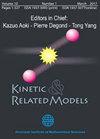晶格Winfree模型的时均匀连续极限与涌现动力学
IF 1.5
4区 数学
Q1 MATHEMATICS
引用次数: 2
摘要
We study a uniform-in-time continuum limit of the lattice Winfree model(LWM) and its asymptotic dynamics which depends on system functions such as natural frequency function and coupling strength function. The continuum Winfree model(CWM) is an integro-differential equation for the temporal evolution of Winfree phase field. The LWM describes synchronous behavior of weakly coupled Winfree oscillators on a lattice lying in a compact region. For bounded measurable initial phase field, we establish a global well-posedness of classical solutions to the CWM under suitable assumptions on coupling function, and we also show that a classical solution to the CWM can be obtained as a \begin{document}$ L^1 $\end{document}-limit of a sequence of lattice solutions. Moreover, in the presence of frustration effect, we show that stationary states and bump states can emerge from some admissible class of initial data in a large and intermediate coupling regimes, respectively. We also provide several numerical examples and compare them with analytical results.本文章由计算机程序翻译,如有差异,请以英文原文为准。
Uniform-in-time continuum limit of the lattice Winfree model and emergent dynamics
We study a uniform-in-time continuum limit of the lattice Winfree model(LWM) and its asymptotic dynamics which depends on system functions such as natural frequency function and coupling strength function. The continuum Winfree model(CWM) is an integro-differential equation for the temporal evolution of Winfree phase field. The LWM describes synchronous behavior of weakly coupled Winfree oscillators on a lattice lying in a compact region. For bounded measurable initial phase field, we establish a global well-posedness of classical solutions to the CWM under suitable assumptions on coupling function, and we also show that a classical solution to the CWM can be obtained as a \begin{document}$ L^1 $\end{document}-limit of a sequence of lattice solutions. Moreover, in the presence of frustration effect, we show that stationary states and bump states can emerge from some admissible class of initial data in a large and intermediate coupling regimes, respectively. We also provide several numerical examples and compare them with analytical results.
求助全文
通过发布文献求助,成功后即可免费获取论文全文。
去求助
来源期刊
CiteScore
2.10
自引率
10.00%
发文量
36
审稿时长
>12 weeks
期刊介绍:
KRM publishes high quality papers of original research in the areas of kinetic equations spanning from mathematical theory to numerical analysis, simulations and modelling. It includes studies on models arising from physics, engineering, finance, biology, human and social sciences, together with their related fields such as fluid models, interacting particle systems and quantum systems. A more detailed indication of its scope is given by the subject interests of the members of the Board of Editors. Invited expository articles are also published from time to time.

 求助内容:
求助内容: 应助结果提醒方式:
应助结果提醒方式:


